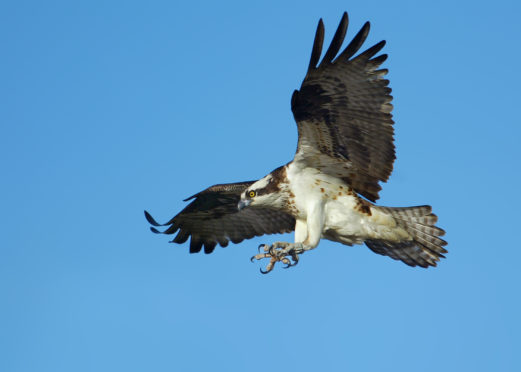It was, oh, so brief; a tantalising glimpse of a large white-winged bird momentarily swirling above a stand of pines. But it was enough, all I needed to satisfy my craving to spot my first osprey of the year.
I always return to this part of central Perthshire at the end of March or in the early days of April as if embarking upon some holy pilgrimage, for there is something addictive about watching these newly arrived ospreys as they swoop and call, seeking out their mates from last year and getting down to the business of renovating their treetop eyries.
My osprey sighting was over in the blink of an eye, but I was elated, not least because I am in continuous awe at their long migration from their wintering grounds in West Africa. But the allure goes much deeper than that, for it is their symbolism that enthrals me; a conservation success story where a once extinct breeding bird in Scotland has made such a remarkable comeback in modern times.
It is not just about the osprey, but a reflection of humankind, too, and how our more enlightened attitude to nature has enabled this bird to prosper once more. No longer a breeder in Scotland at the turn of the 20th century due to egg collecting and persecution, they gradually recolonised under their own steam in the 1950s, and despite some early setbacks, soon became established once more. It is a story to inspire.
Indeed, it had been a good day in so many other ways, too. We had set out early in magnificent spring sunshine and the signs of the season of renewal were all around. The calls of chiffchaffs – a summer visiting warbler – were a continual companion in the wooded areas, and once we broke out onto the open moor, peacock butterflies that had newly emerged from hibernation, flitted and floated by the track edge.
I find it incredible that these fragile fluttering butterflies spent the winter comatose on these moors in the sheltered confines of drystane dykes or in crevices in the ground, enduring penetrating frosts and swirling snow, waiting for the spring warmth to breathe new life into their silky wings. Now, they will mate and lay their eggs, and then perish. But no matter, for the job is done and the next generation of peacock butterflies is on their way.
A male stonechat, with his stunning orange chest and dark head, perched proudly atop a gorse bush, full of cocky bluster as he showed himself off to a nearby female.
And, not long after, by a rocky boulder-strewn spur, we spotted a male wheatear, who was in similarly frisky mood. Like the osprey, he, too, was newly arrived from Africa. This moor, which only a few weeks before had been a quiet and empty place, was now so suddenly full of life and colour. It is the magic of spring.
Info
The first recolonisation by ospreys began in 1954 when a breeding pair settled at Loch Garten near Aviemore. They were soon catapulted right into the forefront of media awareness after their nest was targeted by egg collectors.










